Viva Latino: Flagship Spotify Playlist For The Latin Market
Although it surprising didn't receive any Grammy wins even after its explosive success over the past year, the popularity of Despacito has been a strong indicator of the opportunity presented by the Latin market for streaming platforms. Here we use the Spotify playlist Viva Latino to dig into the bigger picture from a numbers perspective.
________________________
Guest post by Jason Joven of Chart Metric
Chartmetric data as of: Jan 29, 2018
“Latin music has truly become a universal language. We want to not only celebrate, but continue to foster that growth by bringing fans one step closer to their favorite Latin artists, while giving emerging artists a platform to reach new ears.” — Rocio Guerrero, Head of Global Cultures at Spotify (via Spotify blog)
So despite Luis Fonsi and Daddy Yankee’s 2018 Grammy performance as well as their three landmark nominations (Record of the Year, Song of the Year, Best Pop Duo/Group Performance), “Despacito” didn’t win any of them, surprising many due to its unprecedented success as a Latin song on the global stage.
Since we’re into data here at Chartmetric, let’s explore the bigger picture from a numbers angle.
In our Dec 2017 Latin boy band deep dive, we learned there were ~559 million Spanish speakers worldwide. According to the US Census in mid-2016, there were 57.5 million Hispanic people within the leading music market in the world (closely mirroring the 52.6 million Spanish speakers Instituto Cervantes estimated in the US). At the time, that was about 17.8% of the total US population (323.4 million), making them the “largest ethnic or racial minority” in the States.
Or, to Spotify: a really, really good market opportunity– one projected to grow to 119 million in the US alone (28.6%) by 2060.
1.54 billion YouTube views: “Mi Gente” by Colombian artist J Balvin & French producer Willy William (and later Beyoncé in a remix)
Enter: Viva Latino, Spotify’s premiere brand for the best in today’s Latin music. When we explored RapCaviar back in Nov 2017, Spotify’s owned and operated rap playlist campaign was well underway: slick in-house content & graphics, vertical mobile-phone optimized videos, and a live concert series to boot, as The Verge’s Micah Singleton showed us. It is Spotify’s way of diversifying their revenue streams in what is still a complicated and highly political digital music environment.
But how global is Latin music? Sure, Spotify’s Will Page stated how Mexico and Brazil is on track to out-number the UK and Germany in users. Yes, Puerto Rico and Colombia is killing the reggaeton game. And the industry took note when IFPI yet again named Latin America as the fastest growing recorded music market region in 2016 (12% increase in regional revenue) for the 7th year straight.
To answer, we first look to Viva Latino.
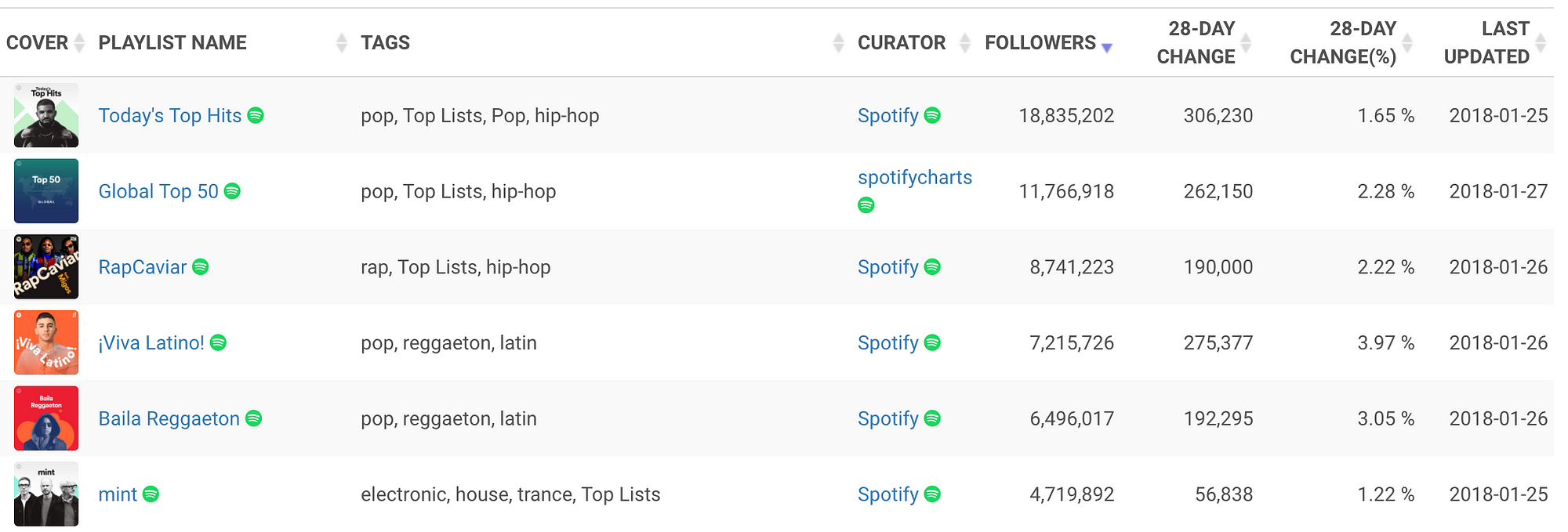
Viva Latino: The Rundown
As Spotify’s #4 most popular playlist with 7.2 million followers (with 9K+ daily growth since May 2017), Viva Latino currently runs behind the pop juggernaut Today’s Top Hits, the Global Top 50, and Tuma Basa’s RapCaviar. It’s backed up at the #5 spot by its closely related sibling, Baila Reggaeton, which shares a whopping 70% of the same tracks (37) as Viva Latino at the time of writing. It’s important to note that despite the similar DNA both lists share, they’re not the same.
While certainly arguable (as are most cultural distinctions), all reggaeton is considered Latin (at least in its Jamaican/Panamanian/Puerto Rican/Carribean origins from the 1990s), but not all Latin is reggaeton. While Baila Reggaeton’s 50 tracks all feature its most distinctive trait- the “3+3+2” riddim (check out Fader’s Adam Harper’s explanation)- not all of Viva Latino’s tracks do. For example, Karol G/Bad Bunny/Quavo’s “Ahora Me Llama (Remix)” features classic trap beats we’re familiar with from recent Migos work, and “Besos En Guerra” brings pop/rock sounds from Colombia’s Morat and Juanes.
Any current similarity will always be a dynamic relationship- akin to disco or grunge briefly dominating US charts in their respective eras- but Latin music will continue to be a collection of diverse voices that speak to its different populations and tastes.
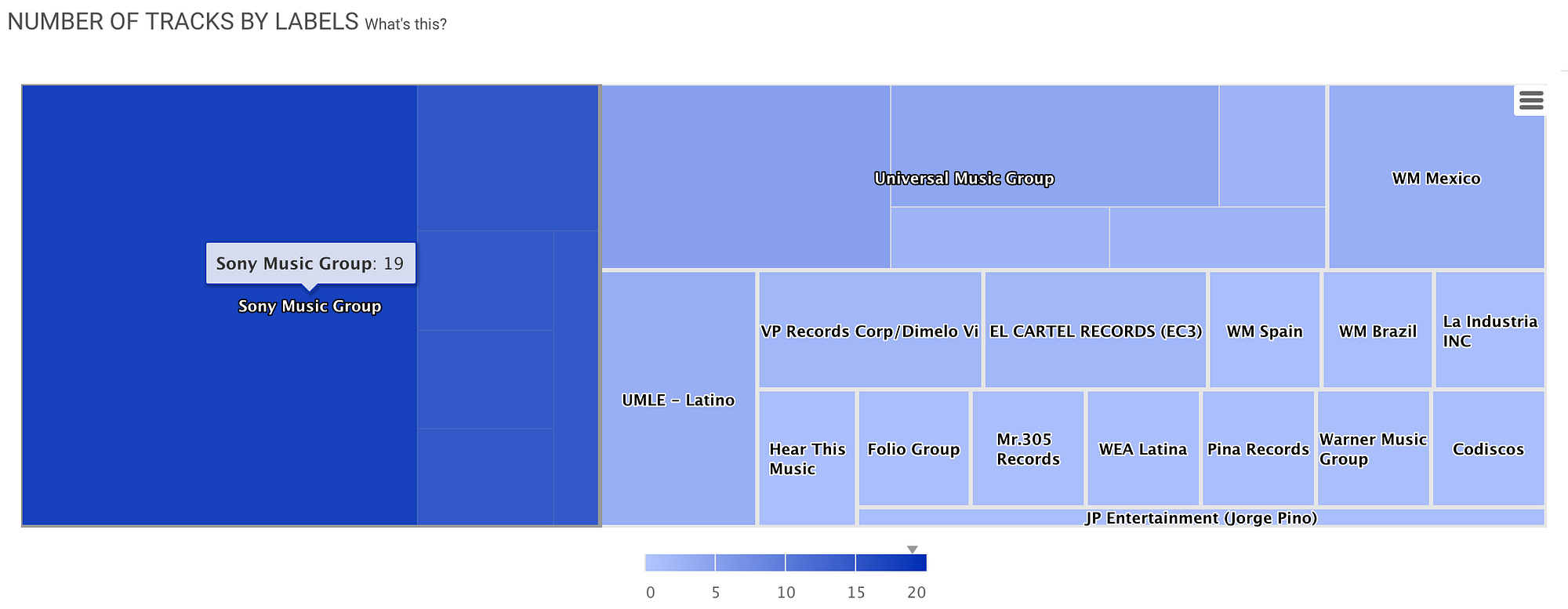
Viva Latino updates its 50 tracks + videos every Friday, and shows a Big Three label shift from what we’re used to in the US pop sphere: Sony Music leads the pack at 19 total tracks. Universal takes a #2 slot (13 tracks) with Warner Music in #3 (7 tracks) with its international affiliates combined.
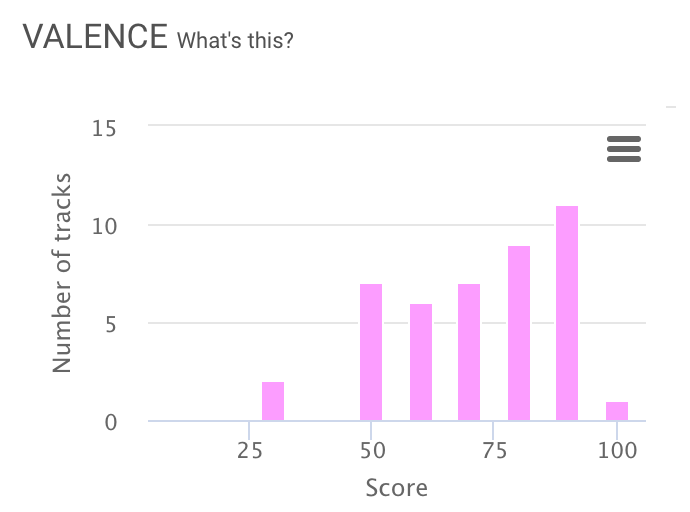
Lastly, as we’ve explored with Echo Nest’s Valence metric (measures the “musical positiveness”) in the past, Viva Latino shows quite the opposite profile from Today’s Top Hits and RapCaviar’s darker, down-trodden moods. With 11 tracks in the 90–100 range and only two ranking below 50, it means that- at least this week- Latin music is happier! ¡Dale!
Looking for Latin, Cross-Platform
To examine Latin music via a generic lens, we take a digital charts approach. If Viva Latino’s 50 tracks are our proxy for the best of the meta-genre streaming worldwide, where else can we find today’s Latin hits, across digital platforms?
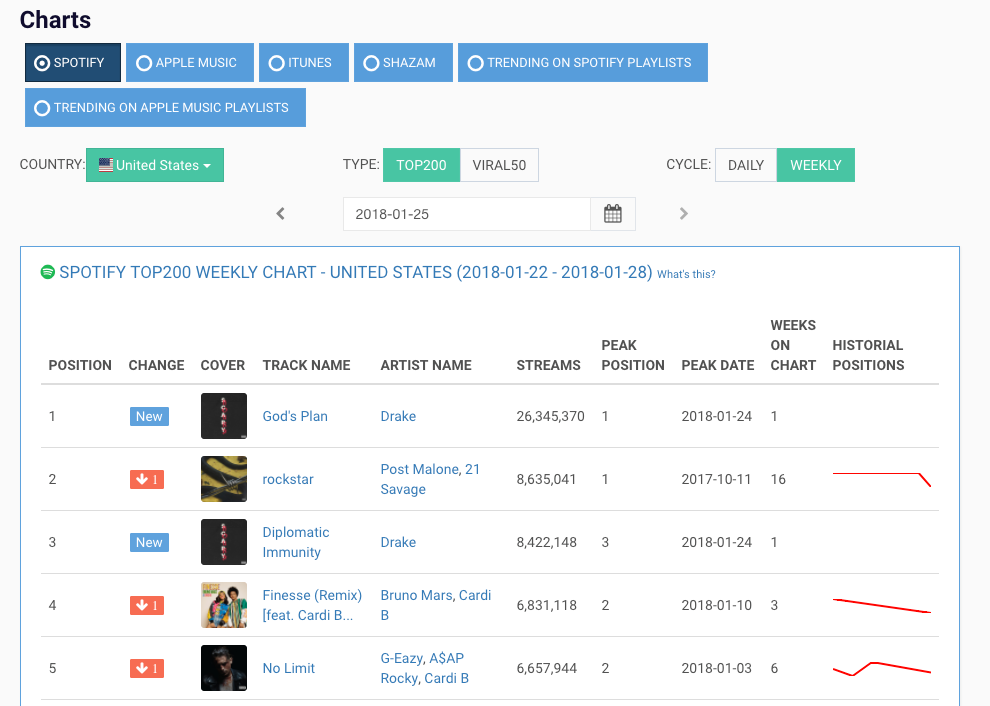
In this crack team of artists, we find multiple appearances from Puerto Rican giants Daddy Yankee, Wisin, Ozuna, and Bad Bunny, as well as Colombian heavy hitters such as J Balvin, Maluma, Sebastián Yatra and Manuel Turizo. Anitta solely represents Brazil with multiple appearances, though the blend of Spanish and Portuguese language continues to be addressed by collaborations such as Maluma’s “Corazón” (video below) featuring Brazilian rapper Nego do Borel. This can only be encouraged by the fact that Brazil is the strongest subscription market in the region towards the end of 2017, according to MIDiA.
We’ve checked how many of the 50 tracks and their artists have shown up through nine key charts for the closest respective time period (week of Jan 25 or day of Jan 25/26) through Spotify, Apple Music, iTunes (downloads), and Shazam.
Each chart has two stats: percentage of exact tracks in common with this week’s Viva Latino playlist and percentage of tracks with those same artists present (many times a remix, sometimes an entirely different track). This way, we can track specific music but also get a sense of any larger trends of today’s Latin stars.
Note the Spotify/Apple Music “Playlists” charts indicate the top 100 releases over the past 30 days that are over-indexing in playlist inclusion, so they’ll point to tracks currently receiving broad reach. This are both filters within the Chartmetric Charts tool- feel free to follow along (on the top navigation bar) if you’re a client!
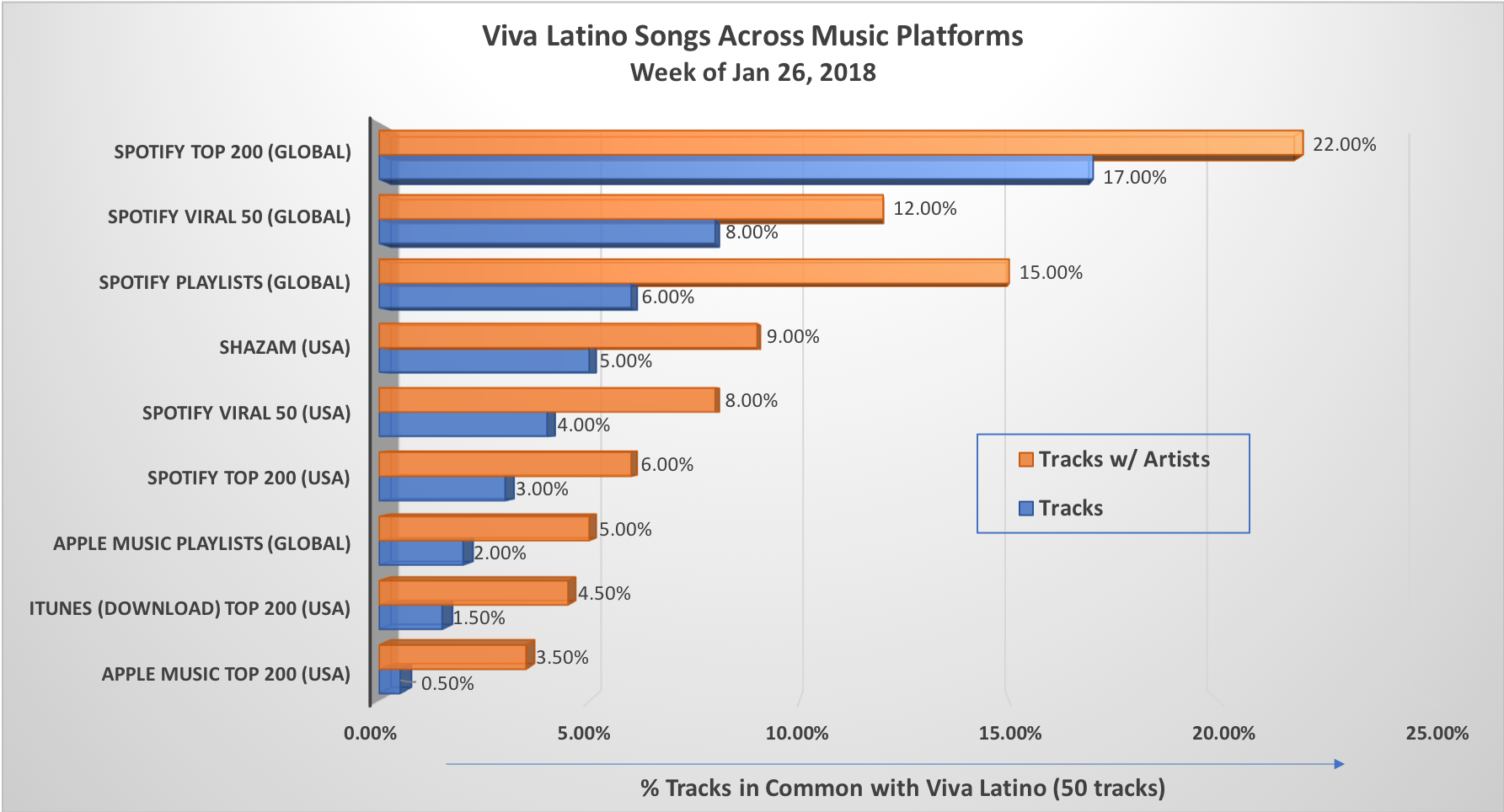
The easiest insights pop out first: naturally, Spotify charts will have most in common with Viva Latino, as Spotify uses their own playlists (in part) to populate it. Spotify’s Top 200 (Global) have the most in common by track (17%) and artist (22%), while its Viral 50 (Global) and Trending on Spotify Playlists (Global) also sit high on our chart.
The globally-oriented charts bubble up toward the top– a nod to the worldwide nature of reggaeton, while the USA region charts sink towards the bottom. In addition, Shazam’s USA Top 100 only had five track matches and nine artist matches, though that’s a unique data source, as it is a subset of the music that its American users experience in the physical world (e.g., what clubs are they going to? Don’t most restaurants/cafes play Top 40 fare?). Nevertheless, the numbers call into question how deep the love is for Latin music stateside, at least from this perspective. From another, the absence of Grammy wins certainly doesn’t help.
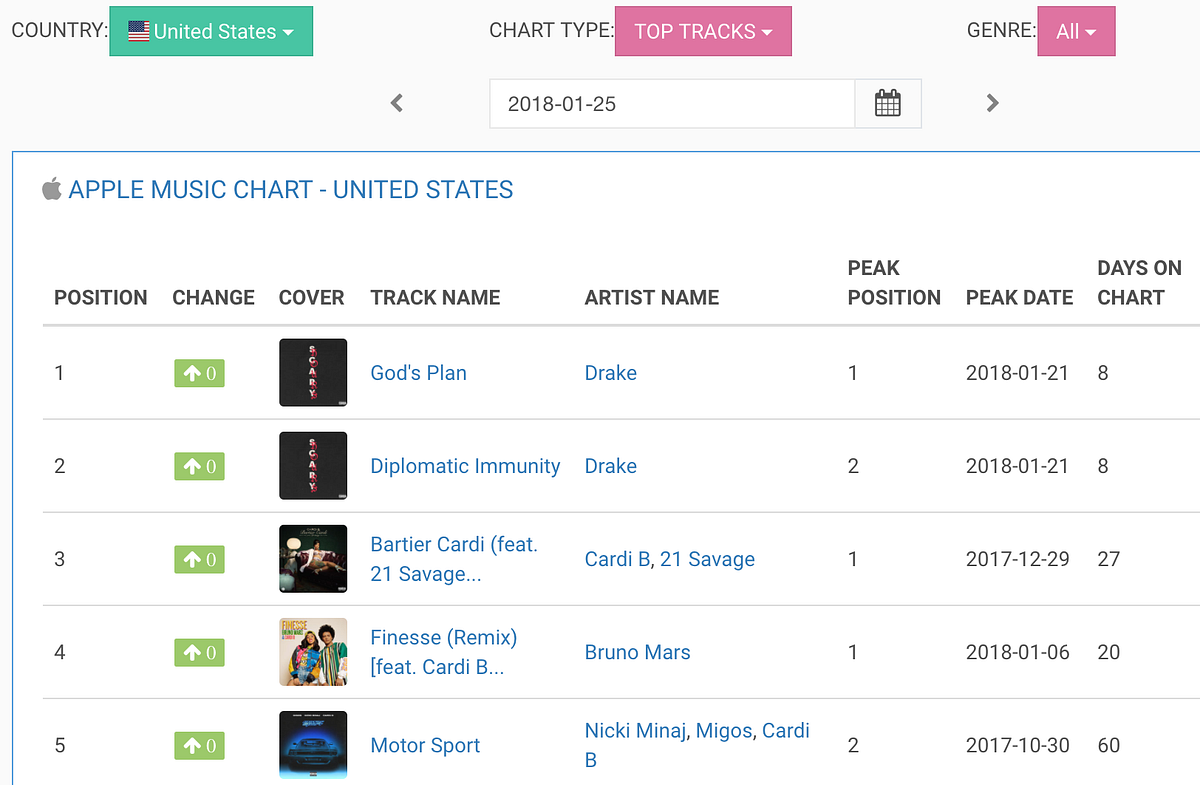
It is also worth noting the relative non-performance of Latin music on Apple Music relative to Spotify. Both are available in the majority of LatAm markets. The only significant differences are Uruguay (Spotify, no Apple Music), and Venezuela (Apple Music, no Spotify). One would expect therefore to see similar proportions of Apple’s hottest charts showing the Latin surge.
While the truth is usually a combination of factors, it may be as simple as lower market share: in Q2 2016, Spotify took 64.1% of the Mexican streaming market compared to Apple Music’s 8.1%. Billboard’s Cherie Hu notes that Mexico has grown from a piracy-laden environment to being the third largest streaming market by volume, and therefore, a big player in the digital space.
Shrewdly, Spotify took a head-start in the LatAm region (with Mexico in 2013), achieving widespread adoption prior to the launch of Apple Music. Chaz Jenkins, CEO of Fumubi and Chartmetric Advisor, believes that impact is multiplied by the readiness of LatAm consumers to engage socially: “LatAm consumers are more likely to use Spotify as a ‘social platform’ rather than simply as a place to listen to music. This can result in rapid escalations in consumption of content anywhere within the borderless Spotify environment, but the results are far more noticeable when content is as such ‘championed’ by LatAm consumers.”
He also notes the nuanced user base/revenue relationship: “And although the common assumption in the US and Europe is that consumers in LatAm regions simply use the ad-funded Spotify tier — an option that is not offered by Apple Music — Spotify’s ratio of subscribers to ad-funded users in key LatAm markets is little different from the global average, and actually exceeds several key European markets. Many of these subscriptions may generate a lower ARPU (average revenue per user) than in Europe, however, it’s important to remember than the LatAm region accounts for two of Spotify’s largest markets measured by number of users.”
What of Latin music’s personalities? The Spotify Playlists (Global) chart features a significant amount of Latin content, yet has 2.5 times more tracks of Viva Latino artists on other releases. With some of these tracks getting serious user-generated playlist attention (e.g., Enrique Iglesias and Bad Bunny’s “EL BAÑO” bowing on 539 and 318 playlists on Spotify and Apple Music respectively), this suggests the broader influence these Latin artists have, outside of whatever tracks Spotify’s brand is deeming important at this time.
Like we’ve seen in RapCaviar artists, Viva Latino’s soldiers are heavy on the collaborations and feature spots, cross-pollinating their audiences to great effect and raising the overall tide. Additionally, Latin artists have the unique option of pulling from various Latin genres to maximize reach, most evident in Maluma’s “Felices los 4”, or loosely translated “The Four of Us, Happy”- releasing a salsa/urban/pop version in addition to the original (which is what is on Viva Latino).

Tracking Latin Sounds Globally
“There are Latin people all over the world, but it’s not just Latin people listening.” — Rocio Guerrero, Head of Global Cultures at Spotify (via Splinter’s Gabriela Resto-Montero)
What will be fascinating to watch is the effect the Latin community will have as it shares its culture, finally unleashed by digital streaming. MIDiA’s Mark Mulligan conceptualized a new globalized streaming paradigm in which Latin America (due to its socio-economics & sheer size) will create new hits through its huge streaming appetite and tip the algorithmic scales at platforms such as Spotify and YouTube. Snowballing into more playlist and recommendation spins, these hits will eventually pop on North American and European users’ radar, whose subscription revenues (due to more established infrastructure) will ultimately fund the next wave of hits. Lather, rinse, repeat.
However it happens, we continue to get closer to a truly global music community, with Jesús Lopéz (UMG Latin America Chief Executive) rightly noting the rising democratization of music consumption. Grammys or not, streaming will be the ultimate arbiter of whose voices get heard on the world stage. More importantly, it will be the gateway to international branding partnerships, foreign touring opportunities, and cross-market collaborations.
Just ask Luis Fonsi: he’s now huge in East Asia with Singaporean star JJ Lin since his latest release on Jan 25, 2018.
It’s a track called “緩緩”. Maybe you’ve heard of it.
I like his new album and i hope he will release a new album soon .
No Hay Un Tike – JOKER – https://song.link/i/1438289179
JOKER is a Cuban entertainer – singer, songwriter, rapper, dancer and record producer – born and raised in Havana, Cuba. With his eccentric street style and humor, he is known as the “JOKER” and “Vufonazo” by the music community of artists, DJs and his fan base in Havana. With no musical boundries, his songs range from Cubaton and Cuban Reggaeton Morffa to Kizomba, Reggae and Electro Trap Latino music.